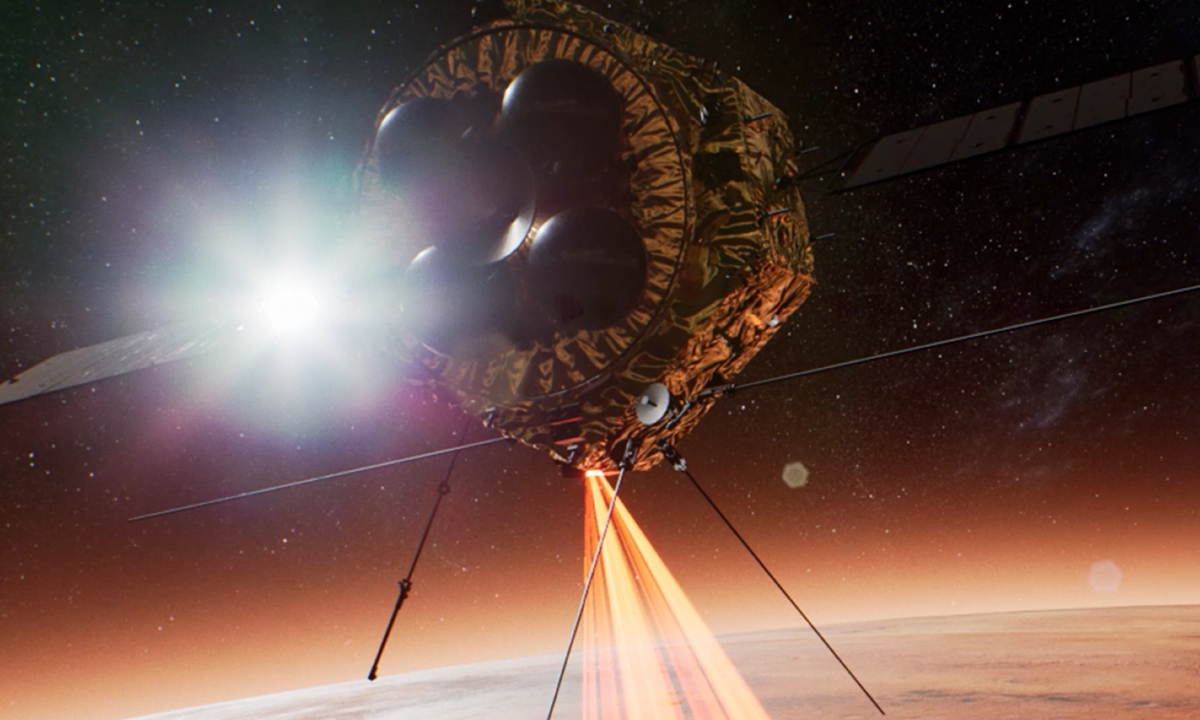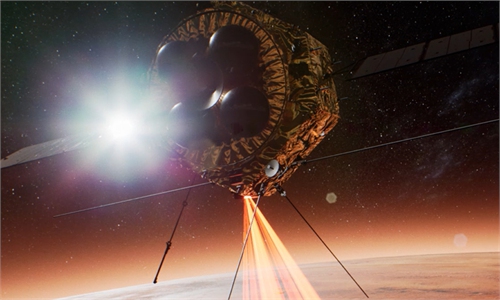SCI-TECH / AIR & SPACE
Chinese major rocket maker envisions reusable Mars Express

Illustration of the Tianwen-1 orbiter in the remote sensing orbit Photo: CASC
Postgraduates of China's largest developer and producer of carrier rockets the China Academy of Launch Vehicle Technology (CALT) have envisioned a reusable transport system that will commute between a future space station in the Mars orbit and the outpost facility on the surface of the Red Planet.
China's first-ever independent interplanetary mission Tianwen-1 reached Mars in February 2021. And as China's space industry marks the one-year anniversary of that, the CALT postgraduates are celebrating by coming up with such a futuristic idea, a source with the academy told the Global Times on Thursday.
Such reusable space-ground transport spacecraft is targeted to offer solutions to the tasks including large-scale Earth-Mars transport and the probe and exploit of the Red Planet.
The distance between Earth and Mars is some 65 million kilometers at closest and some 400 million kilometers at farthest. It took Tianwen-1 295 days to reach Mars from Earth. And if we want to build a base on Mars, it is prerequisite to have such transport to make large-scale Earth-Mars transport and the probe and exploitation of the Red Planet a reality, said Liu Wenjie, one of the CALT postgraduates involved in the project's designing work.
The reusable spacecraft, codenamed the Mars Express, would include modules such as propellant system, take-off and landing device and a vertical tail.
According to Liu, the propellant system of Mars Express, with a specific impulse of 3,700 meters per second, would comprise three liquid oxygen methane-fueled engines of 1.6 million newtons.
Mars Express will commute between the Mars orbit space station and the Mars base on the planet's surface, which is some 125 kilometers above the Mars ground, like a shuttle, transferring payload between the two destinations, Liu said.
The Mars Express will make use of Mars local resources for take-offs from Mars surface before its rendezvous and docking with the Mars space station, Liu explained, noting that the Mars express could also broaden its service scope in Mars orbit in order to increase economic benefits.
Technology of the spacecraft reusability and capability of making use of Mars local resources are key to the Mars Express, which would play a key role in centralize valuable payload especially during the non-transfer period between Earth and Mars when the two celestial bodies are at the farthest from each other, Liu said.
There is also a space shuttle system between Earth and Mars, which connects the two planetary neighbors of the solar system with an eight to 10 months ride and is capable of sending payload of some 150 tons in crewed mode and 200 tons without crew.
According to an illustration with the Mars Express, the space station in the near-Earth orbit is one of the stops for such a space shuttle system. However, Liu did not elaborate on the details about the system.
"Although such idea is difficult to execute, and the design is also quite bold, but isn't it the way how science and technology advances?" Liu concluded.
In fact, Chinese astronomers are not alone in envisioning spacefaring. The US SpaceX has also floated the idea of deploying its Starship spacecraft and Super Heavy rocket to create a reusable transportation system that is capable of orbiting refueling and leveraging Mars' natural water and carbon dioxide resources to refuel on the surface of Mars, in order to achieve the mission from Mars and Back to earth.


